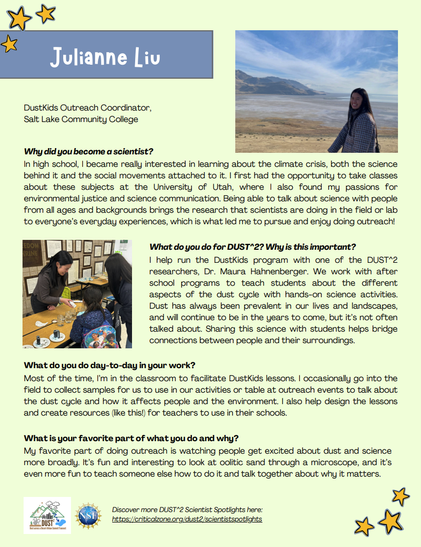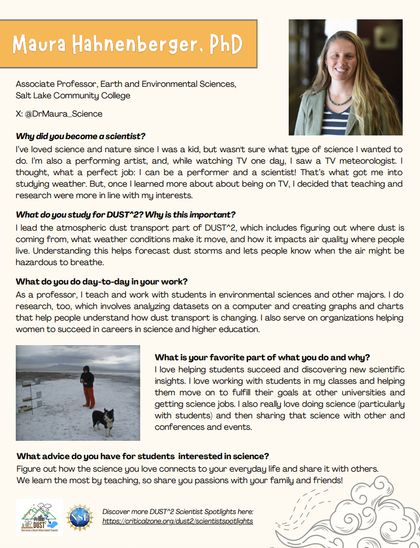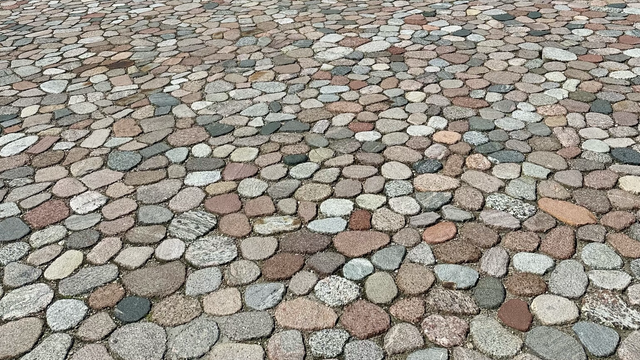Your Critical Zone science deserves to be presented at a conference. The Critical Zone Network of Networks has some funding available to support your travel to that conference. Apply via this link.
#EarthScience
Cluster scientist spotlight!
Julianne Liu DustKids Outreach Coordinator, Salt Lake Community College
Why did you become a scientist?
"In high school, I became really interested in learning about the climate crisis, both the science behind it and the social movements attached to it."
About Julianne: https://bit.ly/44o9sVk
More scientist spotlights: https://bit.ly/4huMS0U
Attention Critical Zone scientists: join this effort to connect researchers from all around the world.
The newly-funded AccelNet project CZ-NoN, work creating a network of networks strengthening connections and developing collaborations between scientists all around the world who are studying the critical zone.
https://www.youtube.com/watch?v=Z-hnpzpl7Yc
More about one of these networks, the OZCAR network in France: https://bit.ly/4fdDm1y
Indonesia's Lewotobi Laki-laki volcano erupts twice in 2 days, unleashing 6-mile-high ash cloud. Via @live_science #EarthScience #Geology #Seismology #RocksForJocks #volcanology 🌋
Indonesia's Lewotobi Laki-laki...
Mysterious Strong Link Between Earth's Magnetosphere and Oxygen Levels. Via @whatdamath #EarthScience #Geology #Seismology #RocksForJocks #Space #Astrophysics #OrbitalMechanics #Astronomy 🚀 🌌 ☄️ 🛰️
Mysterious Strong Link Between...
Shhh. "Don't tell the other collectors," Dust^2 Cluster member Jeff Munroe says. Because out of all 20 instruments in the collector array in the southwestern U.S. this one, Dust 4, is Munroe's favorite.
https://www.youtube.com/watch?v=FvVnAYP1028
More about determining the source of dust in "Isotope fingerprinting reveals western North American sources of modern dust in the Uinta Mountains, Utah, USA" published by Aeolian Research in 2019: https://bit.ly/3YOBQgI
Take a break from your work and spend some time with members of the Dust Cluster.
"Mixing of natural and urban dust along the Wasatch Front of northern Utah, USA" is a product of the Cluster's work over the past few years: https://bit.ly/4ghyW9v
Cluster scientist spotlight!
Maura Hahnenberger Associate Professor, Earth and Environmental Sciences, Salt Lake Community College
What advice do you have for students interested in science?
"Figure out how the science you love connects to your everyday life and share it with others. We learn the most by teaching, so share you passions with your family and friends!"
Some of Maura's work: https://bit.ly/3DT8g1i
More spotlights: https://bit.ly/4huMS0U
Job Alert 🌎
Doktorand:in (w_m_d) – Magnetotellurische Messungen in der Umgebung des Laacher Sees, Deutschland
Deadline: 2025-07-27
Location: Germany, Potsdam, Brandenburg
#hiring #PhD #Geophysics #informatics #physics #EarthScience #geoscience
Stealthy Volcanoes Are Quiet Until They Erupt Without Warning Signs – Here's Why. Via @discover.magazine #Seismology #EarthScience #RocksForJocks #Geology #Volcanology 🌋
Stealthy Volcanoes Are Quiet U...
New paper for the palaeofire fans!
Presenting the SahulCHAR collection, containing 687 sedimentary charcoal records from across Australia, New Guinea, and Aotearoa/New Zealand 🔥
Read it open access here: https://doi.org/10.5194/essd-17-2681-2025
This is the product of my final postdoc role - thank you to the many generous researchers who contributed their data!
Work by Cluster member McKenzie Skiles is cited in this newly published article in Frontiers of Earth Science.
"In recent decades, a growing body of research has focused on characterizing supraglacial microbial communities. These studies have unveiled that pigmented glacier ice algae, namely, Ancylonema nordenskiöldii and Ancylonema alaskanum, blooming during the summer melt seasons accelerate surface melting"
Cluster scientist spotlight!
Dayvon Woodard Undergraduate Student, Geological Sciences, CUAHSI, Western Kentucky University
Why did you become a scientist?
"From an early age, I have always wanted the world to heal and become better, and what better way to heal the Earth than to learn about it through the sciences."
More about Dayvon: https://bit.ly/408eLFK
Complete collection of spotlights: https://bit.ly/4huMS0U
Dust^2 Cluster member Jeff Munroe talks about the importance of studying the movement of dust in the Critical Zone.
https://www.youtube.com/watch?v=B5M4n8Jne9s
This paper by Jeffrey S. Munroe, Abigail A. Santis, Elsa J. Soderstrom, Michael J. Tappa, and Ann M. Bauer and published in SOIL outlines some of the findings Munroe describes in this video: https://bit.ly/4bP8SS8
If you love igneous and metamorphic #rocks, may I recommend Vilnius? #geology #earthscience #travel #lithuania #vilnius
¿Estamos perdiendo la Antártida?: expedición científica encuentra microplásticos y señales de degradación en continente blanco
Microplastics and melting ice reveal deepening crisis in Antarctica
Cluster scientist spotlight!
Otto Lang, PhD PhD Candidate, Geography, University of Utah
What advice do you have for students interested in science?
"Study something you feel a personal connection with and are passionate about. Don't be afraid to reach out to others."
Some of Otto's work: https://bit.ly/3QACXvk
More scientist spotlights: https://bit.ly/4huMS0U
Scientists reveal the hidden trigger behind massive floods
🔬 Meet Dr. Avishek Dutta, Assistant Professor of Geomicrobiology.
As science team member for #IODP3NSF #Exp501 he is investigating life in the sub-seafloor environment. Read the latest blog entry here ➡️ https://expedition501.wordpress.com/2025/06/13/meet-avishek-dutta-looking-for-life/
#EarthScience #ScientificOceanDrilling








